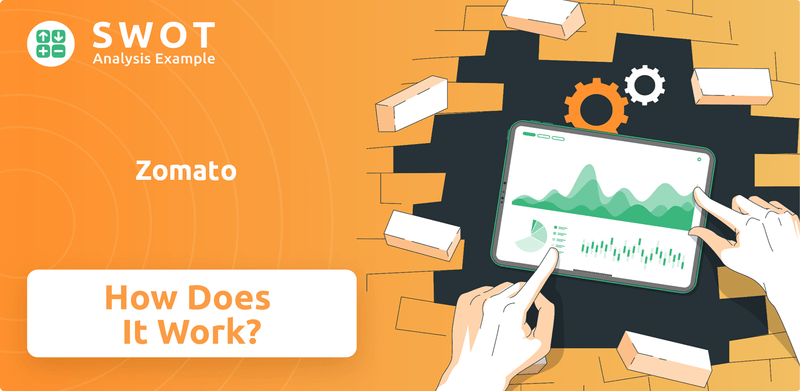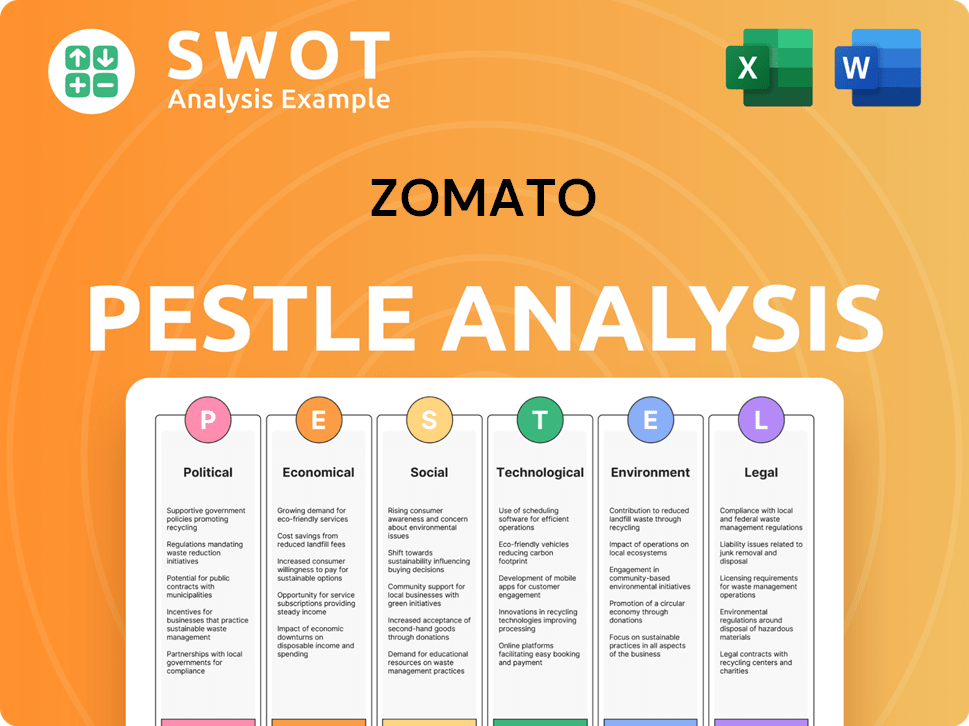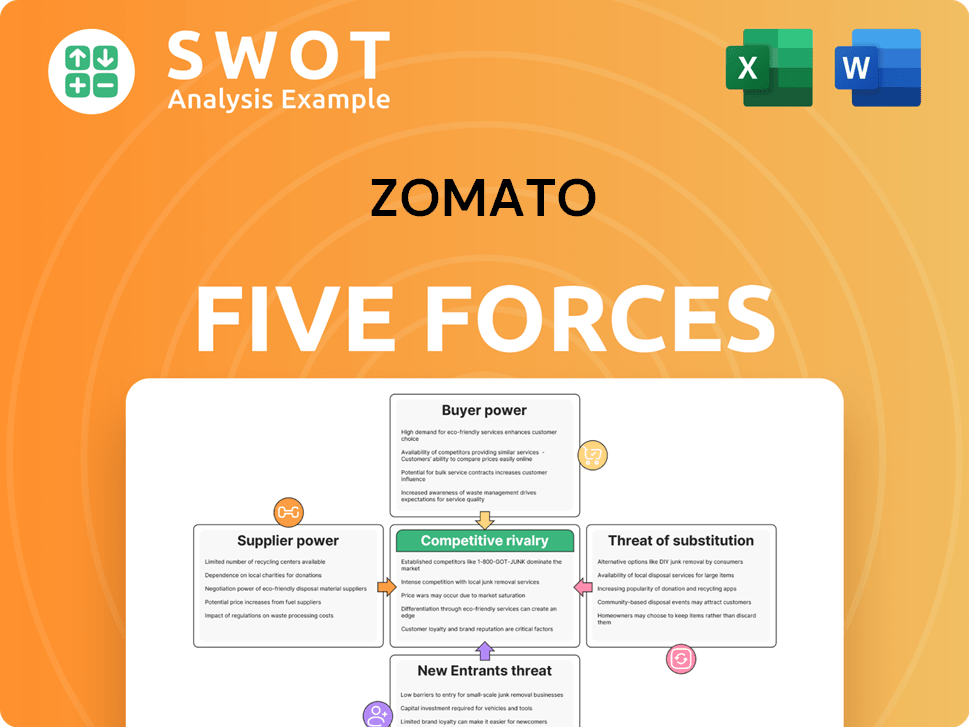Zomato Bundle
How Does Zomato Thrive in the Food-Tech Arena?
Zomato, a leading online restaurant aggregator and food delivery service, has fundamentally altered how we experience food, particularly in India. From its humble beginnings as a digital menu directory in 2008, Zomato has evolved into a sophisticated food-tech powerhouse. Boasting over 70 million monthly active users in 2024, Zomato's impact on the food services industry is undeniable, making it a compelling case study for investors and industry watchers alike.

With consolidated revenue surging in Q3 and Q4 FY25, understanding Zomato SWOT Analysis is crucial to grasp its operational model and revenue streams. This analysis will explore the intricacies of how Zomato works, examining its core value proposition, diverse revenue streams, and strategic initiatives. We'll delve into its competitive advantages and future outlook within the rapidly evolving online food ordering and food delivery service market, providing valuable insights for anyone interested in this dynamic sector.
What Are the Key Operations Driving Zomato’s Success?
The core operations of Zomato revolve around its role as a restaurant aggregator, connecting customers with a wide array of dining options through its app and website. This Zomato business model focuses on providing a convenient platform for online food ordering, restaurant discovery, and table booking services. This approach allows users to easily explore menus, read reviews, and place orders from local establishments, cloud kitchens, and quick-service restaurants.
The company's primary value proposition lies in offering a comprehensive 'one-stop shop' for diverse food experiences. This includes features like online food delivery, detailed restaurant listings complete with menus and user reviews, and table booking services. Zomato's operational model is designed to be user-friendly, efficient, and reliable, aiming to meet the varied needs of its customers.
Zomato leverages advanced AI and machine learning for personalized restaurant recommendations. Efficient order processing and optimized delivery routes ensure a seamless user experience. The company manages a vast network of restaurant and delivery partners.
The platform offers online food ordering, detailed restaurant information, and table booking. Zomato provides user reviews and ratings to help customers make informed decisions. It also offers features like order tracking and customer support.
Zomato operates Hyperpure, a B2B platform that provides kitchen supplies. It offers end-to-end restaurant supply chain solutions. Hyperpure acts as a one-stop shop for the HoReCa industry.
Customers enjoy diverse cuisine options and efficient delivery services. Loyalty programs like Zomato Gold offer free delivery and discounts. The platform emphasizes customer satisfaction through ratings and support.
The effectiveness of Zomato's operations is driven by its strong brand recognition, extensive restaurant network, and user-friendly interface. The company focuses on customer satisfaction, evidenced by a 4.8/5 average customer rating in 2024 and a 24/7 customer support system that has decreased response time by 30%. These core capabilities translate into tangible benefits for customers, including a wide variety of cuisine choices, efficient delivery services, and loyalty programs like Zomato Gold. To understand more about how Zomato has grown, consider reading about the Growth Strategy of Zomato.
Zomato's operational model is multifaceted, using technology to enhance user experience and streamline processes. The company's supply chain involves a large network of restaurant partners and independent delivery partners. Zomato's focus on customer satisfaction and efficient service delivery sets it apart.
- AI and Machine Learning: Used for personalized recommendations and optimized delivery routes.
- Restaurant Network: Extensive partnerships with local restaurants, cloud kitchens, and quick-service establishments.
- Delivery Network: A fleet of independent delivery partners ensuring efficient order fulfillment.
- Customer Support: 24/7 support system to address customer queries and issues.
Zomato SWOT Analysis
- Complete SWOT Breakdown
- Fully Customizable
- Editable in Excel & Word
- Professional Formatting
- Investor-Ready Format

How Does Zomato Make Money?
Understanding the financial structure of the online food ordering and restaurant aggregator, Zomato, reveals a multifaceted approach to revenue generation. The company's success is built on a diverse range of income streams, each contributing to its overall financial health. This diversified strategy allows Zomato to adapt to market changes and maintain a strong position in the competitive food delivery service industry.
Zomato's business model is designed to capture value from various aspects of the food and restaurant ecosystem. From commissions on food delivery to advertising and subscription services, the company has established multiple avenues for generating revenue. This comprehensive approach not only enhances its financial stability but also supports its expansion and innovation in the market.
Zomato's primary revenue stream comes from commissions charged to partner restaurants for food delivery. These commissions typically range from 15% to 25% per order, although this can vary. In Q3 FY24, the food delivery business generated ₹2,025 crore in revenue. This model is a cornerstone of how Zomato works, providing a direct link between order volume and revenue.
Commissions from partner restaurants form the core of Zomato's revenue. The percentage varies, but it's a consistent income source.
Blinkit, acquired in 2022, has seen substantial growth, contributing significantly to Zomato's revenue. Its revenue expanded by 117.23% to ₹1,399 crore in Q3 FY25.
Restaurants pay for premium listings and ads to increase visibility, generating another revenue stream. This helps restaurants reach more customers.
The dining-out service, enabling table bookings, contributed ₹73 crore in Q3 FY24. This service enhances the overall user experience.
Hyperpure, supplying raw materials to restaurants, saw revenue grow 93% year-on-year in Q4 FY25. This B2B arm is a significant growth area.
Subscription services like Zomato Gold/Pro Plus offer benefits like free delivery, attracting subscribers. Over 2 million subscribers were attracted in Q1 2024.
Another crucial revenue stream for Zomato is its quick commerce arm, Blinkit, acquired in 2022. Blinkit's revenue saw remarkable growth, increasing by 117.23% to ₹1,399 crore in Q3 FY25, up from ₹644 crore in the same quarter of the previous year. In Q2 FY25, Blinkit's revenue increased by 129% year-on-year. This expansion highlights the importance of quick commerce in Zomato's overall strategy. The company also generates revenue through advertising, where restaurants pay for premium listings, banner ads, and sponsored content to increase their visibility on the platform. The 'Dining-out' service, which allows customers to book tables and discover restaurants, contributed ₹73 crore in Q3 FY24. Additionally, Zomato's B2B platform, Hyperpure, which supplies raw materials to restaurants, saw its revenue grow 93% year-on-year in Q4 FY25. In Q3 FY25, Hyperpure's revenue grew 95% year-on-year. Innovative monetization strategies include the Zomato Gold/Pro Plus subscription, which attracted over 2 million subscribers in Q1 2024.
Zomato employs various strategies to boost revenue and improve profitability. These include subscription services, AI-driven pricing, and strategic acquisitions.
- Zomato Gold/Pro Plus: Subscription services provide benefits like free delivery and discounts, attracting a large subscriber base.
- AI-Powered Pricing: Dynamic pricing optimizes profit margins and delivery efficiency.
- Strategic Acquisitions: The acquisition of Blinkit has significantly expanded Zomato's revenue streams.
- Overall Growth: In Q4 FY25, Zomato's consolidated adjusted revenue grew 60% year-on-year to ₹6,188 crore.
- Profitability: For the full financial year 2025, Zomato's consolidated net profit increased by 139% to ₹697 crore.
Zomato's monetization strategies are continuously evolving to enhance profitability and user experience. The introduction of AI-powered dynamic pricing is a prime example of how Zomato uses technology to optimize profit margins and delivery efficiency. The company's focus on innovation and strategic acquisitions, such as Blinkit, demonstrates its commitment to long-term growth. For a deeper understanding of the competitive landscape and how Zomato positions itself, consider reading about the Competitors Landscape of Zomato.
Zomato PESTLE Analysis
- Covers All 6 PESTLE Categories
- No Research Needed – Save Hours of Work
- Built by Experts, Trusted by Consultants
- Instant Download, Ready to Use
- 100% Editable, Fully Customizable

Which Strategic Decisions Have Shaped Zomato’s Business Model?
The evolution of Zomato has been marked by significant milestones and strategic decisions that have shaped its business model and financial performance. Founded in 2008 by Deepinder Goyal and Pankaj Chaddah, the company initially focused on compiling online restaurant menus. A crucial early step was securing funding from Info Edge in 2010, which supported Zomato's expansion. The 2021 IPO was a major financial achievement, raising $1.3 billion.
Zomato's strategic moves have been key to its growth. A notable move was the acquisition of Blinkit in 2022 for approximately $568 million, which positioned Zomato in the quick commerce sector. The company also entered the live events and entertainment sector through the District app after acquiring Paytm Insider in Q2 FY25. However, in Q4 FY25, Zomato announced the shutdown of its Zomato Quick and Zomato Everyday initiatives, citing a lack of a clear path to profitability.
Zomato has faced operational challenges, including managing high marketing expenses, such as ₹317 crore in sales promotion and advertising in Q3 FY24. In response, the company has focused on technological advancements, leveraging AI and machine learning. Zomato's competitive advantages include strong brand recognition, an extensive restaurant network, a user-friendly app, and efficient delivery services. The company has also focused on enhancing unit economics by increasing platform fees and streamlining delivery costs. For more details, you can check out the Marketing Strategy of Zomato.
Zomato was founded in 2008. Info Edge provided crucial funding in 2010. The 2021 IPO raised $1.3 billion, marking a significant financial milestone.
Acquisition of Blinkit in 2022 for $568 million. Entry into live events with District app. Shutdown of Zomato Quick and Everyday in Q4 FY25 due to profitability concerns.
Strong brand recognition and extensive restaurant network. User-friendly app and efficient delivery services. Focus on enhancing unit economics through platform fees and cost management.
High marketing expenses, such as ₹317 crore in Q3 FY24. Intense competition within the food delivery and quick commerce sectors. Maintaining market leadership while addressing profitability concerns.
Zomato is leveraging AI and machine learning for personalized recommendations and optimized delivery routes. The company is focused on enhancing unit economics by increasing platform fees and streamlining delivery costs. Management is committed to maintaining market leadership, even if it means deferring profitability in the near term due to competitive pressures.
- AI-driven personalized recommendations.
- Optimized delivery routes.
- Focus on platform fee increases.
- Streamlining delivery costs.
Zomato Business Model Canvas
- Complete 9-Block Business Model Canvas
- Effortlessly Communicate Your Business Strategy
- Investor-Ready BMC Format
- 100% Editable and Customizable
- Clear and Structured Layout

How Is Zomato Positioning Itself for Continued Success?
Let's explore the industry position, risks, and future outlook of Zomato. The company has established itself as a significant player in the Indian food delivery market. However, it faces challenges and opportunities that will shape its future. Understanding these aspects is crucial for anyone interested in the company, from investors to industry observers.
Zomato's operations and financial performance reveal a dynamic company navigating a competitive landscape. The company's success depends on its ability to manage risks, adapt to market changes, and execute its strategic initiatives effectively.
Zomato holds a dominant position in the Indian food delivery market. It commands a market share of approximately 58% as of Q1 FY25. This strong position is a result of brand visibility and customer loyalty.
Zomato faces risks from intense competition, high operational costs, and regulatory changes. Increased expenses, particularly in marketing, can affect profitability. The company must innovate to maintain its competitive edge.
Zomato focuses on strategic initiatives for growth, including expanding into new markets and quick commerce. The company aims for steady profit potential, with an adjusted EBITDA margin guidance of 5-6% of net order value. This approach is designed to drive long-term value.
In Q3 FY25, Zomato's net profit fell by 57.24% to ₹59 crore, despite a 64.38% revenue rise. In Q4 FY25, net profit declined by 77.71% to ₹39 crore. These figures highlight the challenges and the need for strategic adjustments.
Zomato's strategy involves expanding its quick commerce business and diversifying revenue streams. Quick commerce, through Blinkit, aims to reach 2,000 stores by December 2025. The company is also investing in AI and exploring new monetization strategies.
- Zomato is continuously working on enhancing its Brief History of Zomato and staying ahead in the competitive market.
- The company is focused on expanding its market share and maintaining its leadership position.
- Zomato is adapting to evolving consumer preferences and technological advancements.
- The company is exploring new revenue streams and optimizing operational efficiency.
Zomato Porter's Five Forces Analysis
- Covers All 5 Competitive Forces in Detail
- Structured for Consultants, Students, and Founders
- 100% Editable in Microsoft Word & Excel
- Instant Digital Download – Use Immediately
- Compatible with Mac & PC – Fully Unlocked

Related Blogs
- What are Mission Vision & Core Values of Zomato Company?
- What is Competitive Landscape of Zomato Company?
- What is Growth Strategy and Future Prospects of Zomato Company?
- What is Sales and Marketing Strategy of Zomato Company?
- What is Brief History of Zomato Company?
- Who Owns Zomato Company?
- What is Customer Demographics and Target Market of Zomato Company?
Disclaimer
All information, articles, and product details provided on this website are for general informational and educational purposes only. We do not claim any ownership over, nor do we intend to infringe upon, any trademarks, copyrights, logos, brand names, or other intellectual property mentioned or depicted on this site. Such intellectual property remains the property of its respective owners, and any references here are made solely for identification or informational purposes, without implying any affiliation, endorsement, or partnership.
We make no representations or warranties, express or implied, regarding the accuracy, completeness, or suitability of any content or products presented. Nothing on this website should be construed as legal, tax, investment, financial, medical, or other professional advice. In addition, no part of this site—including articles or product references—constitutes a solicitation, recommendation, endorsement, advertisement, or offer to buy or sell any securities, franchises, or other financial instruments, particularly in jurisdictions where such activity would be unlawful.
All content is of a general nature and may not address the specific circumstances of any individual or entity. It is not a substitute for professional advice or services. Any actions you take based on the information provided here are strictly at your own risk. You accept full responsibility for any decisions or outcomes arising from your use of this website and agree to release us from any liability in connection with your use of, or reliance upon, the content or products found herein.